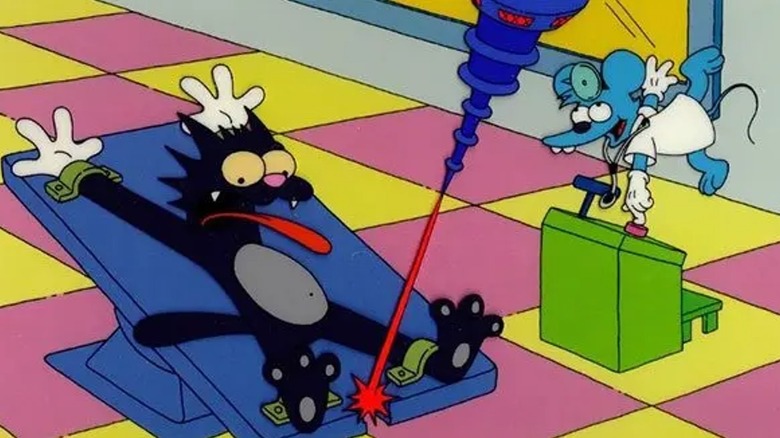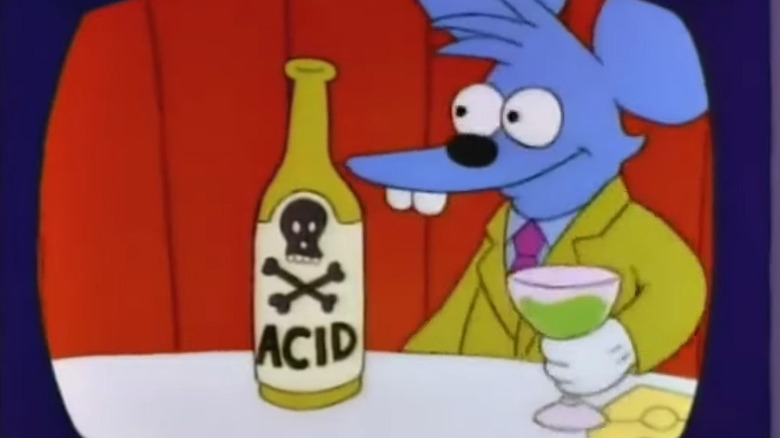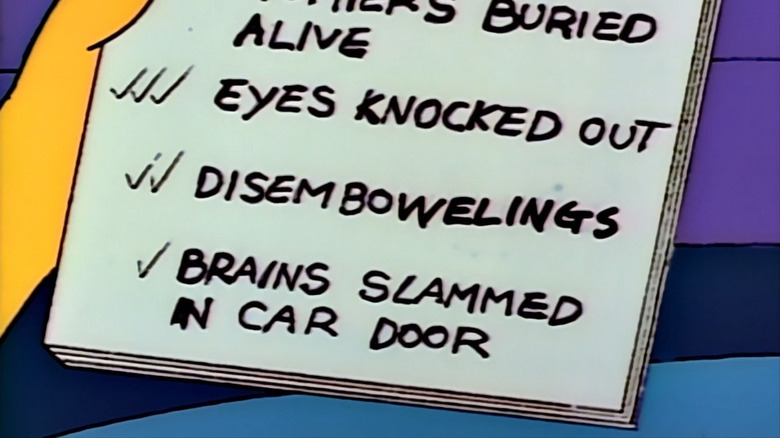Itchy & Scratchy Let The Simpsons Writers Break Every Rule Of TV
Cartoon stars Tom and Jerry were invented by Will Hanna and Joe Barbera in 1940 for Metro-Goldwyn-Mayer. Tom, a mute cat, and Jerry, a mute mouse, starred in 114 theatrical shorts in their initial run from '40 to '58, and won seven Academy Awards. Thanks to the gods of Saturday morning, many Tom and Jerry shorts made their way into heavy rotation on television, and the ultraviolent animal combat films became deeply entrenched in the subconsciousness of several new generations. Tom and Jerry cartoons were typically pretty violent, often featuring new and interesting forms of abuse. Unlike the Coyote and Roadrunner cartoons, wherein a coyote was consistently harmed by his own hubris, Tom and Jerry cartoons were aggressive, even hateful. The characters loathed each other and were eager to do one another harm.
Any kids who grew up with Tom and Jerry, then, instinctively knew the joke at play with "The Itchy & Scratchy Show," Bart Simpson's favorite cartoon on "The Simpsons." Eschewing setup, "The Itchy & Scratchy Show" was little more than a series of gore vignettes wherein a sadistic, bloodthirsty mouse would mutilate, humiliate, skin, flay, and repeatedly murder a panicking, screaming cat. It was Tom and Jerry as reimagined by a serial killer.
The extremity of "The Itchy & Scratchy Show" was far off the beaten path for animators on "The Simpsons," a show that was set in a more recognizably human world than "Tom and Jerry." The show, of course, had its moments of cartoon silliness and outright absurdity, but it was not a show of anthropomorphic animal psychopaths ripping one another's organs out. In a 2021 interview with The New Yorker, longtime "Simpsons" writer John Swartzwelder addressed the creative freedom Itchy and Scratchy provided both the show's writers and animators.
The loophole
One of the things that made "The Simpsons" stand apart from other animated shows at the time was its devotion to a recognizable sitcom universe. The Simpsons lived in a bland, middle-American town in a rundown suburban home. Mom was a homemaker, dad worked at the local power plant, the kids attended public school. In the early days of the show, Homer (Dan Castellaneta) was less a cartoon idiot and more a none-too-bright blue collar boob obsessed with status and brown-nosing his boss. The Simpsons were, however, a little ruder and crasser than the sitcom characters that preceded them; The Simpsons said "damn," dad strangled his son, son was a vandal and a troublemaker, daughter was an unrecognized suffering genius.
Broad cartoon violence was not a part of "The Simpsons" until you got to "Itchy & Scratchy," a parody of cartoons. John Swartzwelder felt that, when making those segments, the show could cut loose and be as outrageous as possible. Indeed, in depicting the show as being bad for Bart and Lisa, Swartzwelder said he could slip otherwise horrible things past the censors. He said:
"We could show horrendous things to the children at home, as long as we portrayed them being shown to the Simpsons' children first. Somehow this extra step baffled our critics and foiled the mobs with torches. We agreed with them that this was wrong to show to children. 'Didn't we just show it being wrong? And, look, here's more wrong stuff!'"
Brains slammed in car door
Indeed, there was an episode of "The Simpsons" from its second season called "Itchy & Scratchy & Marge, which aired December 20, 1990, wherein Marge (Julie Kavner) noticed that the utter shameless brutality of "The Itchy & Scratchy Show" was completely inappropriate for children. She made a checklist of violent acts she witnessed, and it included instances of brains being slammed in a car door. Her crusade was inspired by her infant daughter, Maggie, who, imitating "Itchy & Scratchy," injured Homer with a mallet. The episode is, of course, a satire of media watchdog groups, and Marge is staged as something of a villain for wanting to put the kibosh on fun, violent kid entertainment. However, when the kids grow bored of a sanitized version of the show, they go outside and have more fun playing in the neighborhood than they would watching TV at home.
John Swartzwelder might have known kids were watching "The Simpsons," but it's pretty clear from "Itchy & Scratchy & Marge" that they were simply satirizing the real world, sending up certain sitcom tropes, and, most importantly, trying to make his fellow writers laugh. The writers, he clarifies, were making the show for each other:
"We just tried to make ourselves, and each other, laugh. Comedy writers. That was the audience. Luckily, a lot of other people, both kids and adults, liked the same jokes we liked."
Liked indeed. "The Simpsons" is currently on its 34th season and shows no sign of stopping. Next year, there will be people old enough to run for president who have never known a world without "The Simpsons." Whatever Swartzwelder was doing, he was doing it right.


